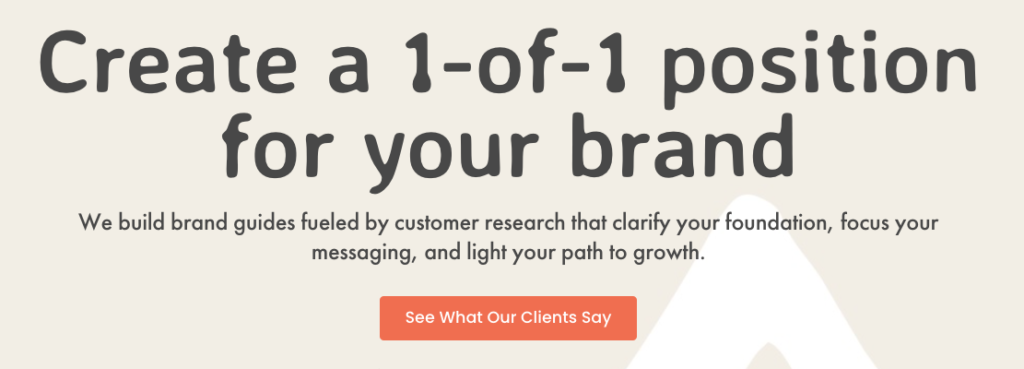
The ultimate goal for your key messages is to align your brand’s unique value with the needs of your customers. And do it in a way customers can easily understand.
You can think of key messages as the first introduction a person gets to your brand. The quality of those messages help determine whether you’re about to start a new relationship with this person or go your separate ways.
This means key messages needs to:
- Provide context around your brand’s category
- Explain the specific value of what you provide
- Highlight memorable points of differentiation
- Make the whole offer feel compelling
For your customers it means that the messages will let them know:
- I’m in the right place
- This offer hits on an important need I have
- The approach is unique and better than what I can get elsewhere
- It’s something I want to get now
It’s a simple formula on the surface, but there’s quite a bit of nuance and complexity baked into it.
Which category do you best fit within? What’s the essence of your value? What actually makes you different? And what words do your customers use to describe these things?
These questions connect back to your overall brand positioning. And they should be informed by customer research to help you understand your audience’s motivations and behaviors.
But there’s another source of data you can use to guide your brand’s key messages. It helps your understand:
- How your customers view their needs
- How customers view the value of your brand
- The words they use to describe that value
That data source is testimonials.
How Testimonials Can Fuel Your Key Messages

As an agency that provides brand strategy, positioning, and customer research services you might think Map & Fire has it easy when it comes to clarifying our own brand.
I really wish that were true.
The truth is we have to work at it just as hard as our clients do.
Yes, we practice what we preach when it comes to building our brand. We regularly work on our strategy and conduct research with our customers.
We also collect customer testimonials from most of our engagements.
But until recently, we hadn’t fully realized what a great data source testimonials could be.
We use a 3rd party review service called Clutch to gather our testimonials. Clutch verifies each testimonial, which proves it really came from the person who worked with us and that we didn’t manipulate it.
What makes these testimonials extra valuable is that Clutch collects them using a structured set of questions, including:
- What services did you hire the company for and what were your goals?
- How did you select this vendor?
- Can you share outcomes from the project that demonstrate success?
- What did you find most impressive or unique about the company?
As we were revisiting our own positioning and messaging, we decided to look at our testimonials to see if there were new insights we could uncover.
We specifically focused on that first question:
“What services did you hire the company for and what were your goals?”
The answers to this question highlighted:
- How clients viewed their needs
- What language they used to describe those needs
That’s exactly what we wanted to understand better.
A 3-Step Process To Analyze Your Customer Testimonials

To break down the testimonials we took three steps:
- Extract the most relevant snippets
- Identify recurring themes
- Rank occurrences of the themes
1. Extract the most relevant snippets
From that question of “what services our clients hired us for”, we pulled out the pieces that best captured their needs.
Here are the snippets:
- “Build solid ground for future growth…”
- “A brand that represents who we are…”
- “How we believe others should see us…”
- “Rebrand and position our products and services…”
- “Before we entered our next growth phase, get our messaging on point…”
- “We had Ambitious growth initiatives…”
- “Understanding of who our customers are, what they care about…”
- “Developing a brand message and positioning within a competitive market…”
- “Build a brand from scratch…”
- “Market and positioning for a new type of program offering…”
- “Be seen and differentiate ourselves…”
- “New messaging that resonated with the C-level executives…”
- “Narrowing down our target audiences…”
- “Position our brand to appeal to those groups of people…”
- “Rebrand before expanding…”
- “Have a solid brand foundation…”
- “Foundational brand strategy…”
Next, we wanted to see which themes each snippet focused on.
2. Identify recurring themes
We looked at the snippets to find words and phrases that came up multiple times.
The 5 that we found were:
- Growth
- Brand Foundation
- Differentiation
- Customer Understanding
- Positioning
Collectively, these themes encapsulate the core of our value. So next we wanted to prioritize them.
3. Rank occurrences of the themes
Going through the snippets we labeled each with the themes they focused on.
For example:
“Build solid ground for future growth…” (Brand Foundation + Growth)
“Understanding of who our customers are, what they care about…” (Customer Understanding)
“Be seen and differentiate ourselves…” (Positioning + Differentiation)
Adding up all the occurrences for each theme we arrived at these totals:
- Positioning (9)
- Brand Foundation (7)
- Growth (4)
- Differentiation (4)
- Customer Understanding (3)
We could then use that data as a guide to refocus our positioning and messaging.
Implement The Themes
In the past, our position and messages had centered around a general theme of “branding built on customer data to fuel growth”.
The problem is that while “growth” is a positive outcome, it felt too broad to be the primary theme. It’s something that almost every B2B service and product touches on in some capacity.
It doesn’t differentiate us.
What this process helped us see was that while our clients do think about growth, it wasn’t the most common way they framed their needs.
The theme that was most top of mind was actually Positioning.
And this made sense in retrospect as our specific approach to brand positioning is a big part of what makes us unique.
This highlighted the importance of refining the order of how we speak to our themes of value.
We used that insight to refine our key messaging and in turn the copy that’s now live on our website.

You can see how we applied each (theme) here:
Create a 1-of-1 position for your brand (Positioning + Differentiation)
We build brand guides fueled by customer research (Customer Understanding) that clarify your foundation (Brand Foundation), focus your messaging, and light your path to growth (Growth).
We felt that this core value proposition of “Create a 1-of-1 position for your brand” set a better context for the specific value that makes Map & Fire special.
The hope is that the “1-of-1” wording piques interest and sparks some emotion to make that idea feel more compelling.
With the subheadline, we provide a little more detail on our unique approach to brand strategy:
- We rely heavily on customer research
- We deliver a guidebook to inform your decision making going forward
Finally, we wove some branding touches into the language: Creating a brand positioning/messaging/research guide (i.e. Map) to light your path to growth (i.e. Fire).
Listen To The Words Your Customers Use

As you work on and refine your brand, you naturally develop ideas of the value you provide to your customers.
The important thing to remember is that those ideas may not always align with how your customers view your value.
Just because you’re in the right ballpark, it doesn’t guarantee you’re on base.
Customer interviews and surveys are a critical part of finding that alignment. But any place where you can capture how your customers speak about your brand’s value using their own words is valuable.
Take a critical look at customer testimonials and reviews. The themes that emerge may surprise you, and they may help you find stronger alignment.

Improve Alignment With Your Customers
If you’re ready to build stronger connections with your customers, reach out for a free consultation. We’ll help you transform your best business thinking into an actionable, shareable, growth-oriented guide. Click below to learn more about the Brand Guidebook process.

